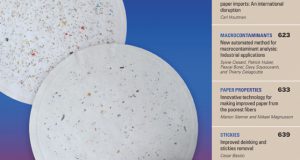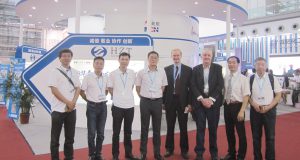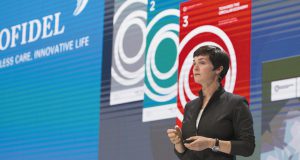![]() The papers summarized here are from the October 2016 and November 2016 issues of TAPPI Journal. TAPPI Journal is an online publication of relevant and timely peer-reviewed research delivered via email and free to all TAPPI members. To receive TAPPI Journal, join TAPPI at www.tappi.org.
The papers summarized here are from the October 2016 and November 2016 issues of TAPPI Journal. TAPPI Journal is an online publication of relevant and timely peer-reviewed research delivered via email and free to all TAPPI members. To receive TAPPI Journal, join TAPPI at www.tappi.org.
OCTOBER
NANOTECHNOLOGY
Preparation and characterization of bioactive and breathable polyvinyl alcohol nanowebs using a combinational approach
Uday Turaga, Vinitkumar Singh, Anna Gibson, Shahrima Maharubin, Carol Korzeniewski, Steven Presley, Ernest Smith, Ronald J. Kendall, and Seshadri Ramkumar
Antimicrobial activity of treated (white) and treated/heat cross-linked (brown) PVA nanowebs on (A) E. coli, and (B) S. aureus.
 Electrospun polyvinyl alcohol (PVA) nanowebs treated with a mixture of honey and polyhexamethylene biguanides (PHMBs, commercially available as Reputex 20) were prepared and characterized to evaluate their applicability in wound dressing applications. Researchers used Fourier transform infrared spectroscopy to confirm the incorporation of functional moieties from honey and Reputex 20 into electrospun PVA nanowebs. Functionalized PVA nanowebs were characterized by evaluating their antimicrobial properties, moisture vapor transport characteristics (breathability), and tensile properties.
Electrospun polyvinyl alcohol (PVA) nanowebs treated with a mixture of honey and polyhexamethylene biguanides (PHMBs, commercially available as Reputex 20) were prepared and characterized to evaluate their applicability in wound dressing applications. Researchers used Fourier transform infrared spectroscopy to confirm the incorporation of functional moieties from honey and Reputex 20 into electrospun PVA nanowebs. Functionalized PVA nanowebs were characterized by evaluating their antimicrobial properties, moisture vapor transport characteristics (breathability), and tensile properties.
Nanowebs fabricated from biocompatible polymers such as PVA, and functionalized in a combinational fashion, could be used in many different biomedical applications, including wound healing bandages and cell or tissue culture scaffolds. The pulp and paper industry could use a similar combinational approach to develop multifunctional textiles for a variety of applications according to their needs.
RECYCLING
Anionically surface treated inkjet and flexographic inks and their deinkability
Veronika Husovska, Jan Pekarovic, Alexandra Pekarovicova, and Paul D. Fleming
Ink removal (from top to bottom) via basic solution, acidic solution, dispersant Solplus D-540, or Varonic T205.
Researchers explored prerecycling of water-based flexographic ink and water-based thermal inkjet inks. Model laboratory formulated water-based flexographic and commercial water-based thermal inkjet inks were used in experiments using solely wet or dry inks. The goal was to optimize ink detachment during repulping and at the same time assure its minimal ink redeposition.
Ink’s behavior was examined under a wide pH range. An alkaline environment is desirable for complete ink detachment from the printed substrate, whereas the benefit of an acid environment is the agglomeration of the pigment in water-based ink. Deinking would be most efficient if executed in two steps: first, alkaline to detach most of the alkaline water-based ink; and second, acidic to maintain detached ink coagulated. Acidic pH has the ability to agglomerate the pigment once it is detached and present in deinking waters. However, such a recycling protocol is likely not achievable in current recycling plants.
Mills can better understand the influence of pH change on the recyclability of water-based flexographic and inkjet inks.
RECYCLING
Passivation of pressure sensitive adhesive stickies by addition of acrylic fibers to OCC pulp before papermaking
Mohammad Hadi Aryaie Monfared, Hossein Resalati, Ali Ghasemian, and Martin A. Hubbe
Micrographs of PSA surface that was treated with acrylic fibers. An arrow shows an acrylic fiber partly covering a large flake of PSA in the sheet.
This study investigated the addition of acrylic fiber to old corrugated container (OCC) pulp as a possible means of overcoming adverse effects of water-based pressure sensitive adhesives (PSA) during manufacture of paper or paperboard. Such adhesives can constitute a main source of stickies, which hurt the efficiency of the papermaking process and make tacky spots in the product.
The highest amount of acrylic fiber added to recycled pulps generally resulted in a 77 percent reduction in accepted pulp microstickies. The addition of acrylic fibers also increased pulp freeness, tear index, burst strength, and breaking length, though there was a reduction in screen yield. Hence, in addition to controlling the adverse effects of stickies, the addition of acrylic fibers resulted in the improvement of the mechanical properties of paper compared with a control sample.
These research results reveal possible ways to employ plastic fibers in recovered fiber furnish as a means of overcoming problems with stickies. Not only can the stickies be passivated, but paper properties can be improved as well.
NOVEMBER
NANOTECHNOLOGY
Novel CaCO3-polymer nanocomposite fillers for the improvement of bagasse-based papers
Shakkthivel Piraman, Maruthaiya Karupaiah, Ramalakshmi Mariappan, Srinivasan Alagar, and Kim Min
Field emission scanning electron microscopy images of (a) blank paper, (b) paper filled with nano-CaCO3 filler, and (c) paper filled with PAM-modified nano-CaCO3 filler.
Polymeric inorganic nanocomposites have received considerable attention because of their potential application in diverse areas, including papermaking industries. To develop novel filler materials to improve important paper properties, polyacrylamide (PAM)-coated nano-calcium carbonate (CaCO3) nanocomposite fillers were synthesized and studied for their chemical and morphological characteristics.
The effect of PAM-modified CaCO3 nanofillers on properties of paper made with bagasse-based pulp was evaluated and compared with papers made with pristine nano-CaCO3 fillers. The Fourier transform infrared spectroscopy results confirmed the attachment of PAM/CaCO3 nanocomposites with the cellulosic fiber matrix. The scanning electron microscope and light microscopic images confirmed that the PAM-modified CaCO3 fillers deposited larger aggregated clusters of particles on the fiber surfaces more firmly, which caused the improved paper properties. The surface and the optical properties of the bagasse papers filled with PAM preflocculated-CaCO3 nanofillers were tremendously increased without sacrificing strength properties because of the increased fiber-filler-fiber bonding.
In industrial applications, PAM/nano-PCC composite fillers could be used to improve the optical and surface properties of paper.
FIBER SUPPLY
Effect of eucalyptus bark contamination during pulping of mixed southern hardwoods
Ricardo B. Santos and Peter W. Hart
The use of eucalyptus as a partial replacement for mixed southern hardwoods can result in significant amounts of eucalyptus bark being incorporated into the chips going to the digester. When eucalyptus is first harvested, the bark  peels off in large sheets, which will pass through chippers designed for southern hardwood. After being cut for more than about 4–6 weeks, the bark tightens onto the bole of the tree and again passes through chippers not designed for eucalyptus. As a result, significant quantities of eucalyptus bark could go to the digester.
peels off in large sheets, which will pass through chippers designed for southern hardwood. After being cut for more than about 4–6 weeks, the bark tightens onto the bole of the tree and again passes through chippers not designed for eucalyptus. As a result, significant quantities of eucalyptus bark could go to the digester.
This study describes the effect of pulping eucalyptus bark in the laboratory. A series of control studies were performed on eucalyptus and mixed southern hardwood bark. The results show that incorporating bark into the cook results in increased kappa number, decreased pulp yield, and increased alkali consumption. If the percentage of applied active alkali is increased to counteract the increased alkali consumption, increased hexenuronic acid is generated.
The data in this study could be used to help justify in-woods debarking of eucalyptus to avoid contamination issues or to predict potential operational problems associated with partial substitution.
PAPERMAKING
The influence of strain rate and pulp properties on the stress relaxation of wet paper—modeling of relaxation
Jarmo Kouko, Joonas Sorvari, and Elias Retulainen
Tension-time curve of the measurement data with the straining, relaxation, and de-straining phases. BHKP 100 kWh/ton at 48% solids content with strain rate 1%/s.
The time-dependent stress (tension) relaxation behavior of wet paper plays a key role in web transfer from the press to the dryer section of a paper machine. In this study, researchers used three linear viscoelastic models to predict the short time range tension relaxation of wet paper.
Over longer time periods, all three models gave relaxation moduli that were apparently linear on a logarithmic timeline. However, the results showed that the tension relaxation of wet paper had more than one characteristic time constant, meaning that the initial tension relaxation phase had a different constant than the later phase or phases. In practical applications, the most relevant time range for runnability of the wet paper web is from milliseconds to a few seconds. The obtained results suggest that the strain rate and initial tension of the relaxation dictate the shape of the tension relaxation curve of wet paper: the higher the strain rate, the greater the tension loss during the first second of relaxation. The tension relaxation behavior of wet paper did not generally depend on pulp type, refining level of pulp, or solids content. However, there can be significant differences between furnishes and solids content in the amount of draw that leads to a sufficient web tension. The results indicated that the tension relaxation behavior of wet paper may be based on a general viscoelastic mechanism that is independent of fiber network properties but depends on the fiber wall material.
The process efficiency of paper and board making can be improved, especially in unstable or in problematic running conditions, by taking full advantage of this proposed, relatively simple modeling method for the relaxation behavior of wet paper webs.
 Paper 360
Paper 360


